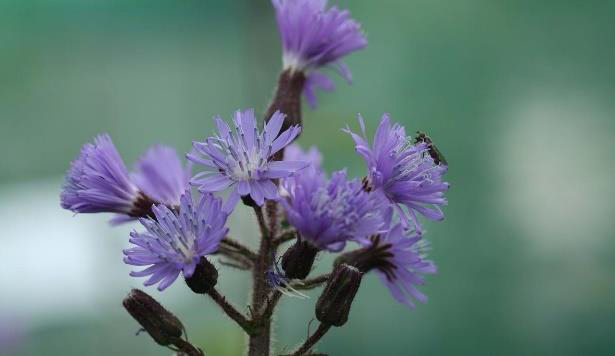
RES www.hilloffare-windfarm.co.uk
The project team has adjusted its plans in the light of the feedback received and is holding a second round of consultation. It is also preparing to start work on both the peatland restoration and preparing the ground for tree planting. By the time that you read this, you will have had an opportunity to visit a drop-in session and should be seeing work on the moor itself. Due to timing, we will comment on the plans in the next issue.
A wind farm of 17 giant turbines is currently proposed for the Hill of Fare. These turbines will be 250m tall; the tallest onshore wind turbines in the UK. The combination of tall turbines on a prominent hill will disfigure the landscape for miles around. RES, the project developer, has now completed the second round of public consultations and expects to submit a formal planning application later this year.

RES www.hilloffare-windfarm.co.uk
The proposal is being vigorously opposed and readers are referred to the local campaign group's website, Hill of Fare Windfarm Information Group — This contains a variety of useful information and paints a far more complete picture than we could here.
The John Muir Trust has issued an open letter to the Scottish Government calling for a carbon emissions land tax. See www.johnmuirtrust.org/support-us/take-action/982-carbon-emissions-land-tax The idea is simple. Large holdings of land would be liable for a tax depending on how much carbon the land emits. For example, an area of damaged and eroding peatland emits carbon and would be liable to pay the new tax. In contrast, an area of restored peatland absorbs carbon and would not be liable to pay the tax. Similarly, an area of trees growing in an appropriate soil absorbs carbon and would not be liable to pay tax. In principle, well managed land would pay no tax and land managed, e.g., for shooting, would be subject to taxation. The threshold size of holding would be adjusted so that typical farms would not be liable. The tax would be ringfenced and spent on local community projects. The idea is to "encourage" people owning large areas of land to manage their land with a view to reducing carbon emissions. Of course, the devil lies in the detail.
At this stage, it's just an idea, but an interesting one.
The Royal Botanic Garden of Edinburgh (RBGE) has an important role in focussing on rare, threatened and important plant species. They use a combination of genetic and ecological methods to help answer key ecological questions and inform conservation and management decisions.
One such example is the Alpine blue sowthistle (Cicerbita alpina), which exists in only four very small natural populations in the UK, all of which are in Scotland in the Cairngorms National Park.
 RBGE scientists have collected plant material from these sites in the Cairngorms, taken them to their laboratory, examined them genetically and grown them at RBGE. These have been taken to the Cairngorms and replanted in sites away from risks provided by herbivores (sheep, deer) in order to reduce the species' extinction risk. The aim is to create populations that will produce viable seed, and be able to adapt to future environmental change. This work is conducted in close partnership with NatureScot to help deliver the Cairngorms Nature Action Plan.
RBGE scientists have collected plant material from these sites in the Cairngorms, taken them to their laboratory, examined them genetically and grown them at RBGE. These have been taken to the Cairngorms and replanted in sites away from risks provided by herbivores (sheep, deer) in order to reduce the species' extinction risk. The aim is to create populations that will produce viable seed, and be able to adapt to future environmental change. This work is conducted in close partnership with NatureScot to help deliver the Cairngorms Nature Action Plan.
Mountaineering Scotland in their magazine (Scottish Mountaineer) marked Mental Health Awareness Week in May. It asked some of their favourite mountain-goers how going out in the hills in Scotland helped their own mental health. This included a long list of walkers and climbers including Keri Wallace, Cameron McNeish, David Whalley, Lorna Kerr etc. and they all pointed out the wellbeing benefits of being out in the hills and connecting with nature. This is what Robert Mackenzie, Climb Scotland said: "I use climbing as a therapy in different ways depending on what I need at the time. Life comes with different stresses … climbing as a whole gives me the holistic therapy to maintain my mental health"
The magazine also features website information about where to find support with mental health issues including Mountains Mend Minds (www.mountainsmendminds.com) This features blogs, stories and blog contents as well as organising group walks — check out the website for more information.
Ultra-runner Jamie Aarons finished the challenge in 31 days 10 hours and 27 minutes, breaking the previous record by more than 12 hours. The challenge saw Aarons ascend 459,000 ft, the equivalent of climbing Mount Everest 16 times. She began the attempt at Ben More on the Isle of Mull on 26 May and finished at Ben Klibreck in Sutherland in the Scottish Highlands. She ran, cycled and kayaked between each of the Munros, covering a total of around 932 miles (1,500km) on foot and about the same distance by bike. Her power naps lasted all of 1 minute! Aarons, who works as a social work adviser for the Scottish Government, is originally from California but moved to Scotland in 2005.
The Shared Rural Network has called on the UK Govt. to pause its roll-out of digital connectivity due to concerns over where these Phone Masts are being located. Davie Black, Access and Conservation Officer for Mountaineering Scotland, said: "In a digital age, we need greater connectivity but this should focus on communities and businesses rather than map coordinates. We are greatly concerned that hundreds of unnecessary masts could be installed in sensitive mountain areas, along with tracks and other infrastructure, with the sole objective of meeting a pointless and purely geographical target."
Please let the webmaster know if there are problems with viewing these pages or with the links they contain.